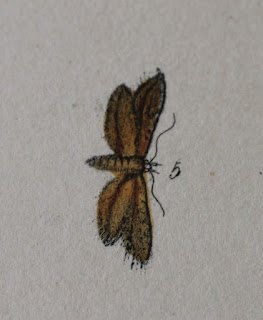 |
| (Evergestis pallidata) |
Our next showstopper is the Evergestis pallidata, one of the bigger micros with astonishing markings. Shaped like a bulgy arrowhead, the creamy colored moth is fashioned with “hieroglyphs” in thin black lines, recalling for me the benzene rings I used to draw in organic chemistry. The termen is sharply delineated; an oblique and ink-washed streak shoots out from the apex. ‘Euergēs’ means well made and ‘esthēs’ garment – funny how we like to imagine these markings that are part of their anatomy (more like tattoos really) as items of clothes, e.g. argyresthia ‘silver dress’, the use of ‘cloak’ in several vernacular names, and so on. The second part of the name, pallidus means pale, and -ata a suffix for geometry. The larvae for this species live in flocks and feed on Winter-cress. The adults enjoy a fairly long flight season from May to September.
 |
(Evergestis pallidata) The Grey Pearl
|
Here’s an illustration of our moth in the Humphrey book. I like how the wings are tinted with pink to suggest a pearly gloss.
 |
| (Helcystogramma rufescens) |
Quite a different vibe is given off by the Helcystogramma rufescens. Not an arrow but a spearhead this time, the moth is almost uniformly reddish and overlaid with a light vein mark that branches at one-half like the Wainscots. Remember that thing where you try to touch your nose with your tongue? This moth does that very well, curving its palps all the way up to the crown of the head (don't try this at home). The antennae flatten out against the wings and are quite long, about half the wing length. Rufescens, or reddish, describes its ground-color.
 |
| Helcystogramma rufescens - Illustration |
It
is named the ‘dwarf wainscot’ in this old illustration, under the genus Cleodora. Kleodora, was a prophetic
nymph, who could tell the future by throwing pebbles. Does the oracle foretell the
incoming of more new species?
The
number of species is now 387.
Post: Tung Chau (UPenn)




